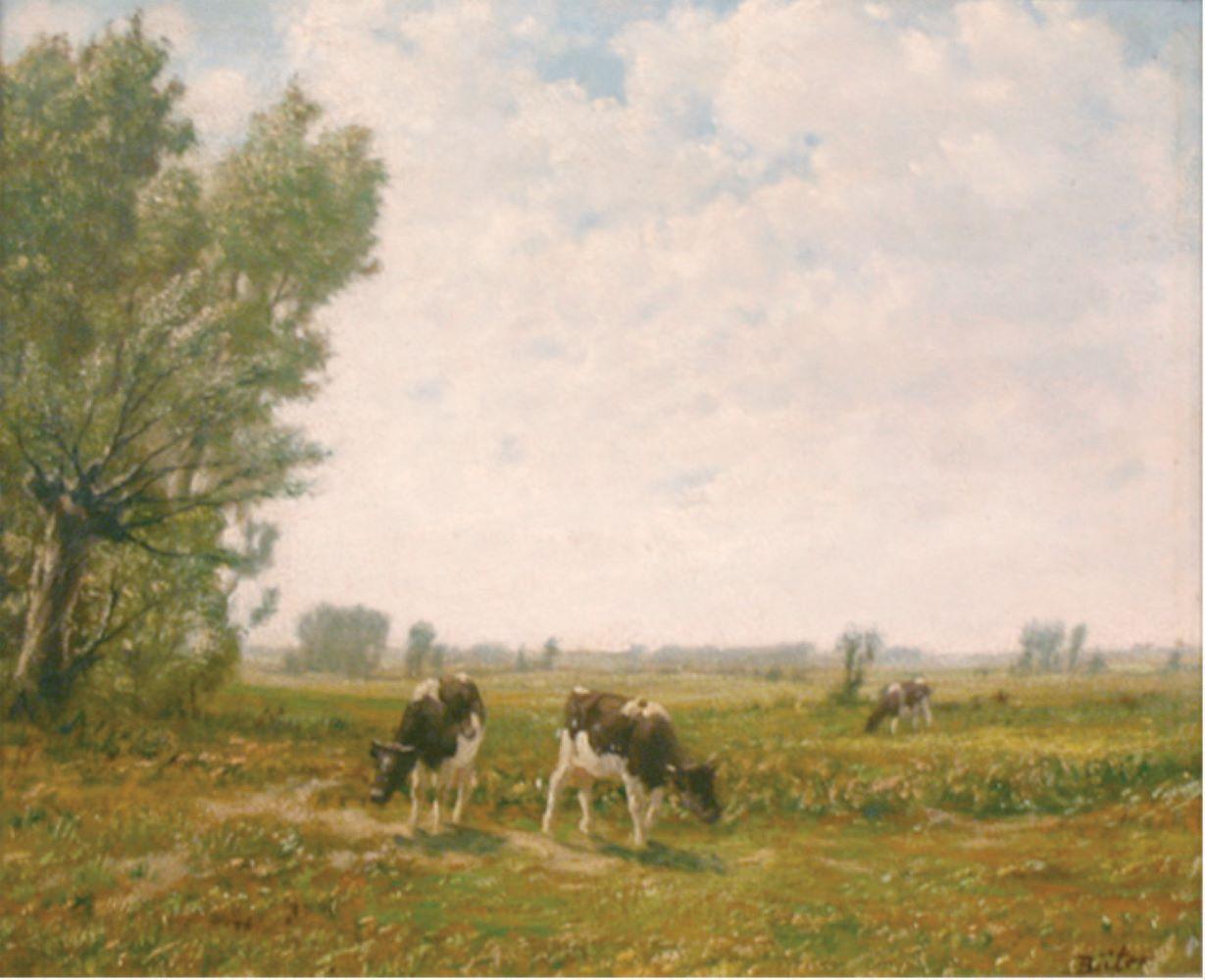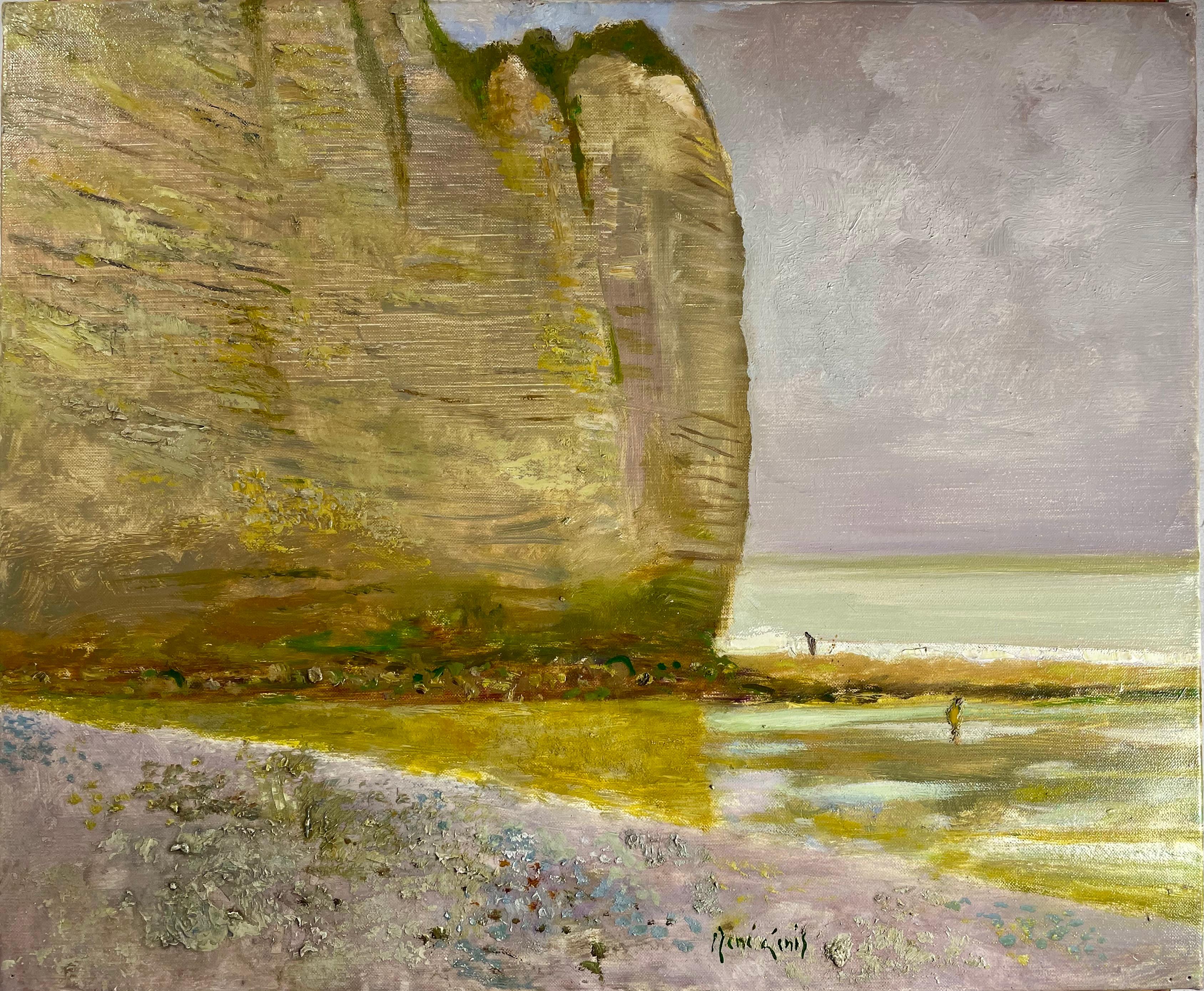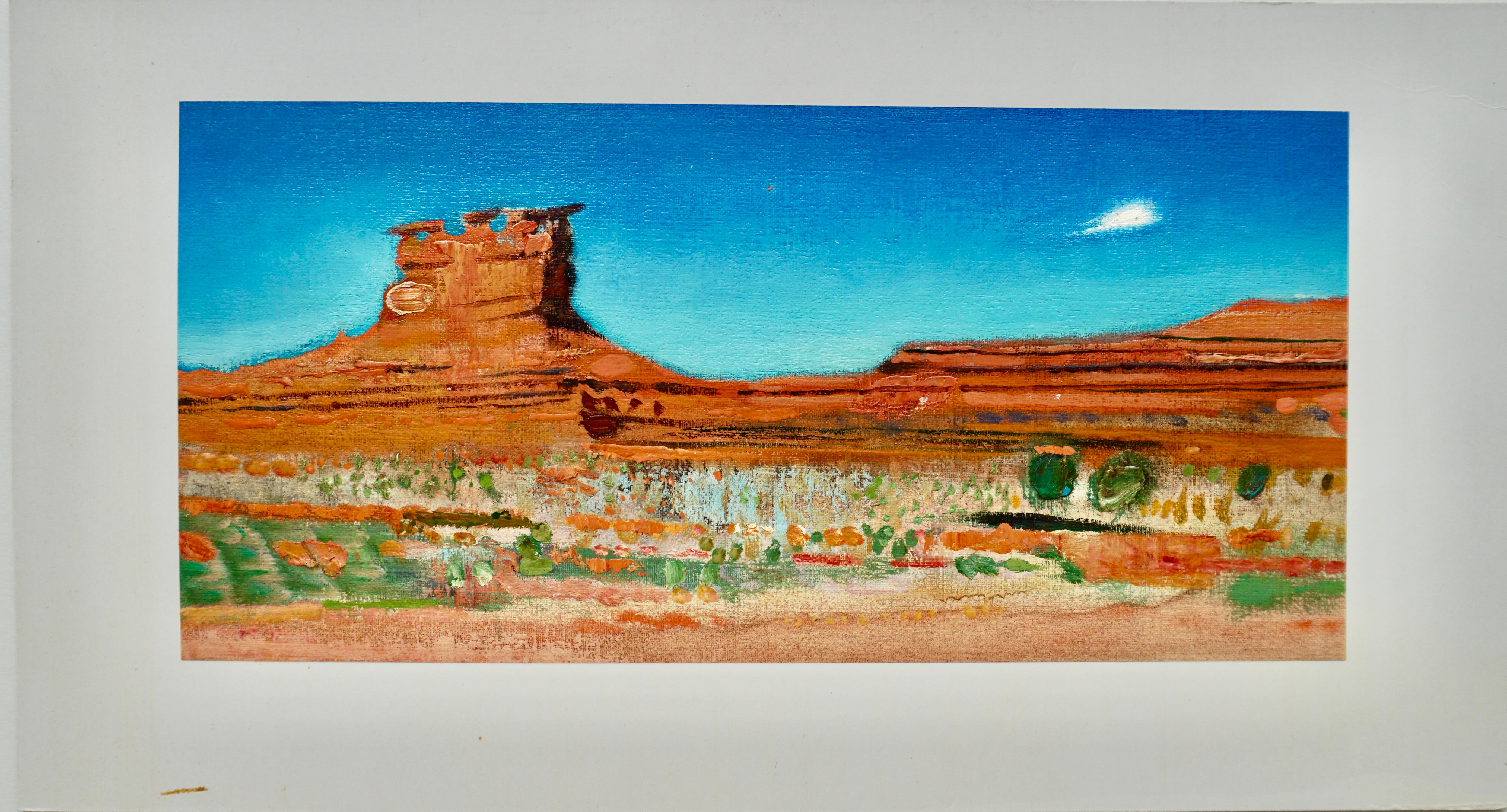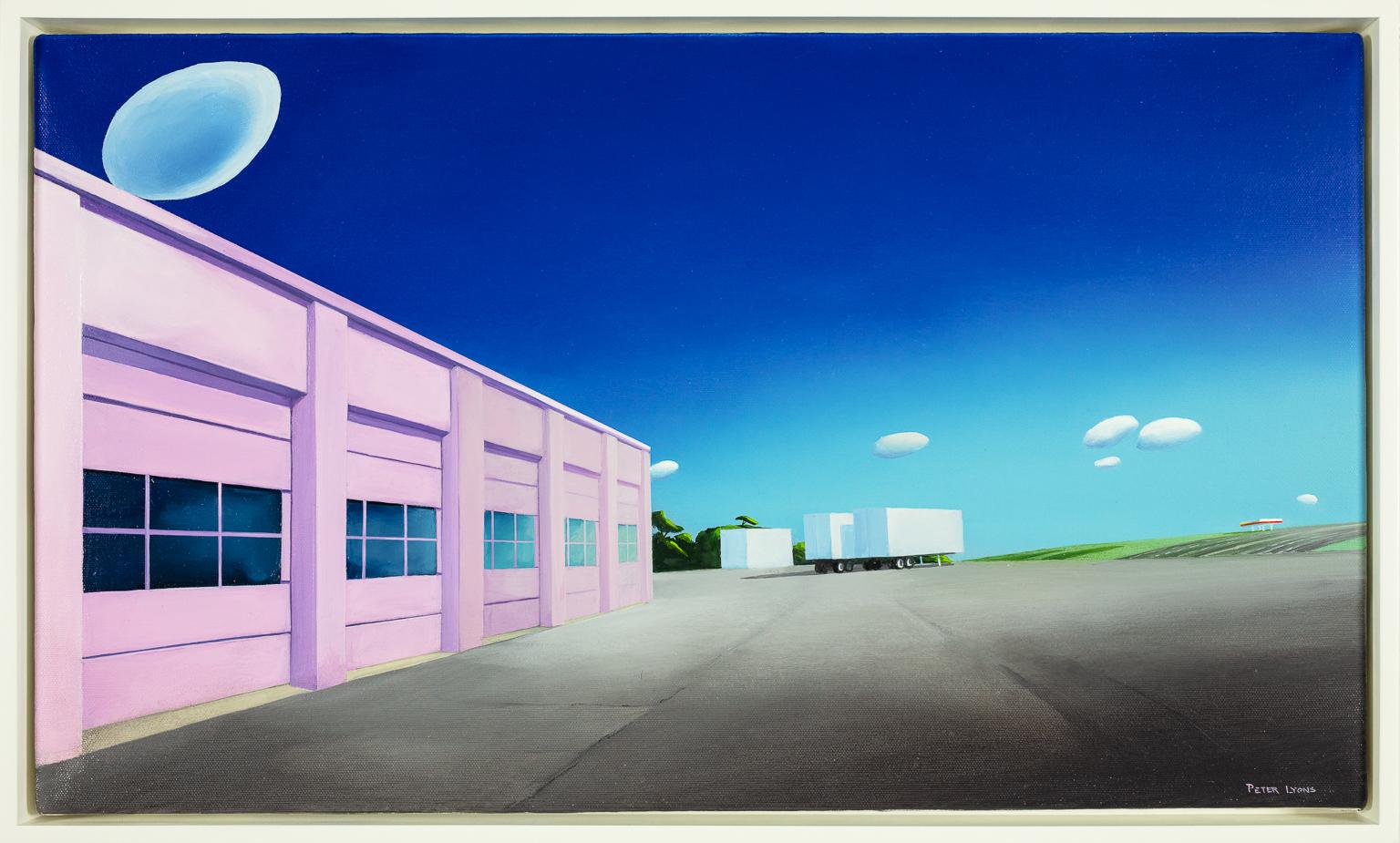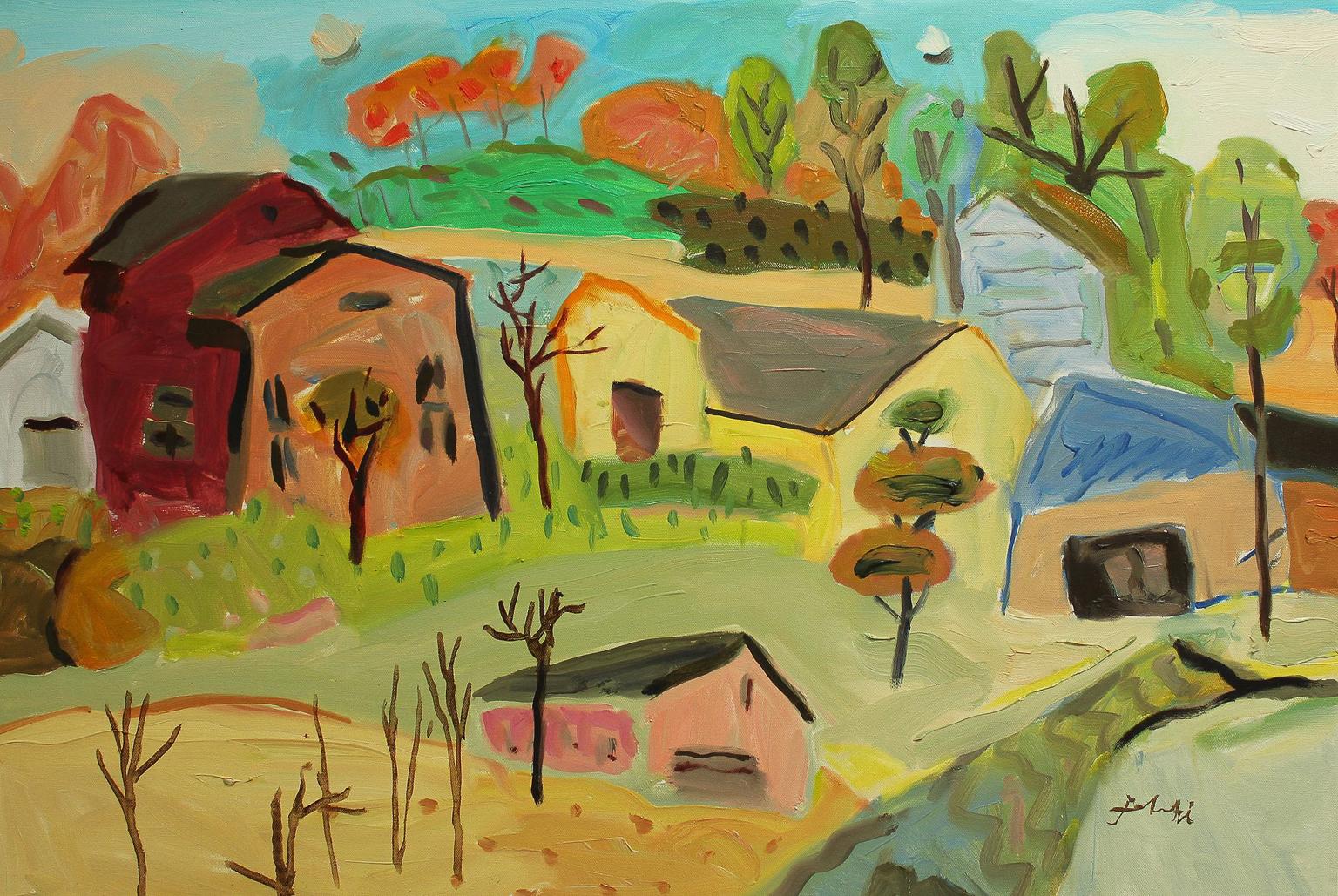Items Similar to "Off Route #5, Guilford, Vermont" Wolf Kahn, New England Landscape with Barn
Want more images or videos?
Request additional images or videos from the seller
1 of 5
Wolf Kahn"Off Route #5, Guilford, Vermont" Wolf Kahn, New England Landscape with Barn1975
1975
About the Item
Wolf Kahn
Off Route #5, Guilford, Vermont, 1975
Signed lower right; dated and inscribed "#63" on the reverse
Oil on canvas
24 x 34 inches
An important member of the second generation New York School, Wolf Kahn is renowned for his luminous, richly colored landscapes. Focusing on such thematic imagery as the tended fields, houses and sturdy barns of New England, Kahn's work represents a masterful synthesis of illusionistic representation and abstraction.
Kahn was born in Stuttgart, Germany, in 1927. As a boy, he studied painting and drawing in Frankfurt. In 1939 his family separated by the Nazi upheaval, Kahn was sent to Cambridge, England, with other refugee children. One year later he arrived in New York City, where he was united with his father, a noted musician. Kahn continued his education at the New York High School of Music and Art, graduating in 1945. During 1946 after a brief period of service in the Navy, he worked under Stuart Davis at the New School for Social Research. From 1947 until 1949, Kahn attended Hans Hofmann's School of Fine Art in New York. He also spent a summer as Hofmann's studio assistant in Provincetown.
In 1950 Kahn enrolled at the University of Chicago, receiving his bachelor's degree a year later. After a period of traveling across the continent and working in Oregon as a lumberjack, he returned to New York and resumed painting. In 1956, along with several other of Hofmann's former students, he helped found the Hansa Gallery, one of the first artists' co-operative loft galleries. During these years, Kahn was one of several young artists, including Elaine de Kooning and Robert De Niro, who were influenced by action painting but, at the same time, felt the need to reintroduce nature back into their art.
Kahn's early work consists of still lifes and figure studies, which show the influence of Hofmann's "push-pull" space as well as his gestural energy. However, Kahn's mature style revolves around the portrayal of un-peopled landscapes in which he combined an expressive chromaticism (inspired by Milton Avery and Mark Rothko) with an emphasis on the dynamics of light and atmosphere. Many describe him as a Luminist, carrying on the 19th century tradition but with a thoroughly modern sensibility. Kahn drew much of his subject matter from the landscape in and around his farm in Vermont, where he spent his summers.
Kahn had numerous solo exhibitions, organized by such institutions as the San Diego Museum of Art (1984, 1987), the Munson-Williams-Proctor Institute (1882), the Arts Club of Chicago (1981) and the Rhode Island School of Design Museum (1979). He was also the recipient of many awards and prized, including a Guggenheim Fellowship (1966-67).
- Creator:Wolf Kahn (1927, German)
- Creation Year:1975
- Dimensions:Height: 25 in (63.5 cm)Width: 35 in (88.9 cm)
- Medium:
- Period:
- Condition:
- Gallery Location:New York, NY
- Reference Number:1stDibs: LU1841213711612
About the Seller
5.0
Platinum Seller
These expertly vetted sellers are 1stDibs' most experienced sellers and are rated highest by our customers.
Established in 2021
1stDibs seller since 2022
59 sales on 1stDibs
Typical response time: 1 hour
- ShippingRetrieving quote...Ships From: New York, NY
- Return PolicyA return for this item may be initiated within 3 days of delivery.
More From This SellerView All
- "November, " Bruce Crane, Tonalism Landscape Autumn Scene, American ImpressionismBy Bruce CraneLocated in New York, NYBruce Crane (1857 - 1937) November Oil on canvas 25 x 30 inches Signed lower right Robert Bruce Crane was an American painter. He joined the Lyme Art Colony in the early 1900s. His ...Category
Early 20th Century Tonalist Landscape Paintings
MaterialsCanvas, Oil
- "Pastoral Landscape, " William Hart, Hudson River School, Cloudy View with CowsBy William HartLocated in New York, NYWilliam Hart (1823 - 1894) Pastoral Landscape, 1877 Oil on canvas 9 1/2 x 14 1/2 inches Signed and dated lower left Born in Paisley, Scotland, William Ha...Category
1870s Hudson River School Landscape Paintings
MaterialsCanvas, Oil
- "Other Side of Town (Leading to Pigeon Cove), " Anthony Thieme, Rockport Cape AnnBy Anthony ThiemeLocated in New York, NYAnthony Thieme (1888 - 1954) Other Side of Town (Leading to Pigeon Cove) Oil on canvas 30 x 36 inches Signed lower left Provenance: David H. Hall Fine Art, Dover, Massachusetts Vose Galleries, Boston, Massachusetts Private Collection, New Jersey Anthony Thieme was born in the Dutch port city of Rotterdam in 1888. He studied at the Academy of Fine Arts in Rotterdam, at the Royal Academy at the Hague, as an apprentice to George Hoecker, a well known stage designer in Düsseldorf, Germany, and to Antonio Mancini, an Italian Impressionist. After completing his studies, Thieme journeyed throughout Europe and South America, working in stage design to support his travels. Thieme first came to the United States in 1917 and initially worked as a set designer and book illustrator first in New York and later in Boston. By the late 1920s, Thieme had married and moved from Boston to Cape Ann in Rockport, Massachusetts, an emerging art colony. Like the other Rockport artists...Category
Early 20th Century American Impressionist Landscape Paintings
MaterialsCanvas, Oil
- "Last Light, Landscape at Sunset, " William Keith, California Tonalist, ForestBy William KeithLocated in New York, NYWilliam Keith (1838 - 1911) Last Light, Landscape at Sunset Oil on canvas 25 x 30 inches Signed lower right A native of Scotland, William Keith became in the late 19th and early 20th centuries a leading Northern-California landscape artist. In fact, he was so well known that he is referred to as the "Dean of California painters." His romanticized views of nature found much favor among the culturally aspiring citizens of San Francisco and hung in many foyers and dining rooms in their elegant homes. He completed thousands of paintings and drawings, and many of them were lost in his studio in the fire of 1906. His early works are dramatic mountainscapes in a realistic style adopted from the Dusseldorf School of Germany. The paintings of the last two decades of his life are looser and obviously influenced by his exposure in France to the Barbizon School of landscape painters, who were the first colony of painters to complete paintings "en plein air," or directly from nature rather than in studios. A forerunner of Impressionism, this style also included Tonalism espoused by Barbizon painter Camille Corot [1796-1875] and also apparent in Keith's later works, which are darker, smaller, and much more intimate with emphasis on mood. Born in Aberdeenshire, Scotland, Keith came to New York with his family and, apprenticed to a wood engraver. In 1859, he moved to San Francisco where he worked for an engraver and later set up his own engraving business. Studying with Samuel Marsden Brookes in 1863, he determined to become a painter. He married artist Elizabeth Emerson and did watercolor painting with her guidance. In 1868, he became a full-time painter, and that same year was commissioned to paint scenes along the Columbia River including Mount Hood. By August 1869 he had sold enough paintings to finance an extended journey to the East Coast and Europe including Dusseldorf, Germany throughout most of 1870, studying with Albert Flamm. After a visit to Paris, he expressed great admiration for "the modern school of French landscape painting including the Barbizon School. During the winter of 1871-1872, the Keiths lived in Boston where they shared a studio with William Hahn. Keith's work received critical acclaim there and in New York at the National Academy of Design. In 1872, he returned to San Francisco. A friendship with naturalist John Muir exposed Keith to many remote places and in-depth knowledge of nature. During the 1870s, he painted several "epic" eight by ten-foot High Sierra views. He also visited Alaska, and his paintings of Alaska were exhibited upon his return to San Francisco in a show at the Bohemian Club, titled 'Dreams of Alaska'. Keith's Alaska works are significant because they are not close transcriptions of actual scenery, but rather are fantasies inspired by Alaska. They are important as they represent a major break from the documentary tradition in landscape painting of Alaska, as they show an interest in capturing its spirit versus just the topography. The first wife of William Keith died in 1882, and in 1883, he married Mary McHenry, the first woman graduate of Hastings Law School. They soon went to Europe, and Keith studied portrait painting in Munich with consultations from J. Frank Currier and Carl Marr for two years. Keith then settled for the remainder of his life in Berkeley, California, at 2207 Atherton Street. His studio was in San Francisco where he commuted daily, painted prolifically, and taught many classes, mostly for aspiring female artists . In 1891, he shared his studio for several weeks with East Coast Tonalist George Inness, Sr. [1825-1894]. Both men painted in a similar style and were followers of the mystical teachings of Swedenborg. Among the locations where Inness and Keith painted together were Monterey and Yosemite, and it was reported they discussed art from every possible angle. Under Inness' influence, Keith painted more than ever in a Barbizon-influenced vein with many sunset and twilight scenes. By the early 1900s, Keith was likely one of the wealthiest artists in the United States and certainly earned the most money of any California-based artist. People from all over the world sought out his studio where it was said that he would specially select a painting for a client from behind a black velvet curtain...Category
Late 19th Century Tonalist Landscape Paintings
MaterialsOil, Canvas
- "Meadow Landscape in Summer, " Harold Dunbar, Factory Scene, ImpressionismBy Harold DunbarLocated in New York, NYHarold C. Dunbar (1882 - 1953) Meadow Landscape in Summer, 1929 Oil on canvas 17 1/2 x 21 inches Signed and dated lower left Harold C. Dunbar — painter, teacher, writer, and illustrator — was born in Brockton, MA on December 8, 1882. He resided in Chatham, MA and died in 1953. His work includes portraits, landscapes, street scenes, still lifes, harbors and coastal scenes. Dunbar studied with Ernest Lee Major (1864-1950) and Joseph De Camp...Category
1920s American Impressionist Landscape Paintings
MaterialsCanvas, Oil
- "Tully Lumber Mill, Orange, Massachusetts, " Dorothy Eaton, WPA Factory RuralLocated in New York, NYDorothy Eaton Tully Lumber Mill, Orange, Massachusetts, 1935 Signed and dated lower right Oil on canvas 17 1/2 x 23 1/2 inches Dorothy Eaton was born in East Orange, New Jersey in 1893. She studied at Smith College...Category
1930s American Realist Landscape Paintings
MaterialsCanvas, Oil
You May Also Like
- Bernhard ButerLocated in Saint Augustine, FLArtist: Bernhard Buter (1883-1959) German Title: Rhinish Landscape Medium: Oil on Canvas Dimensions: Framed 19” x 21” , Unframed 11 x 13” Bernhard Buter paints agrarian landscapes i...Category
Early 20th Century Realist Landscape Paintings
MaterialsCanvas, Oil
- "Les Falaise Normande" (The Cliffs Of Normand)By René GenisLocated in Berlin, MDRene Genis (French 1922-2004) “Les Falaise Normande” / The Cliffs of Normand. A sea scape with high cliffs, the beach, and two fishermen. The cliffs are in browns, tans and olives a...Category
1990s French School Landscape Paintings
MaterialsCanvas, Oil
- "Monument Valley"By René GenisLocated in Berlin, MDRene Genis (French 1922-2004) Monument Valley. 1967. Beautiful oranges, browns, greens against a turquoise blue sky. Oil on canvas, laid on mat. Si...Category
Mid-20th Century Landscape Paintings
MaterialsOil, Canvas
- Early oil depicting the Great Fire of LondonLocated in London, GBThe Great Fire of London in September 1666 was one of the greatest disasters in the city’s history. The City, with its wooden houses crowded together in narrow streets, was a natural fire risk, and predictions that London would burn down became a shocking reality. The fire began in a bakery in Pudding Lane, an area near the Thames teeming with warehouses and shops full of flammable materials, such as timber, oil, coal, pitch and turpentine. Inevitably the fire spread rapidly from this area into the City. Our painting depicts the impact of the fire on those who were caught in it and creates a very dramatic impression of what the fire was like. Closer inspection reveals a scene of chaos and panic with people running out of the gates. It shows Cripplegate in the north of the City, with St Giles without Cripplegate to its left, in flames (on the site of the present day Barbican). The painting probably represents the fire on the night of Tuesday 4 September, when four-fifths of the City was burning at once, including St Paul's Cathedral. Old St Paul’s can be seen to the right of the canvas, the medieval church with its thick stone walls, was considered a place of safety, but the building was covered in wooden scaffolding as it was in the midst of being restored by the then little known architect, Christopher Wren and caught fire. Our painting seems to depict a specific moment on the Tuesday night when the lead on St Paul’s caught fire and, as the diarist John Evelyn described: ‘the stones of Paul’s flew like grenades, the melting lead running down the streets in a stream and the very pavements glowing with the firey redness, so as no horse, nor man, was able to tread on them.’ Although the loss of life was minimal, some accounts record only sixteen perished, the magnitude of the property loss was shocking – some four hundred and thirty acres, about eighty per cent of the City proper was destroyed, including over thirteen thousand houses, eighty-nine churches, and fifty-two Guild Halls. Thousands were homeless and financially ruined. The Great Fire, and the subsequent fire of 1676, which destroyed over six hundred houses south of the Thames, changed the appearance of London forever. The one constructive outcome of the Great Fire was that the plague, which had devastated the population of London since 1665, diminished greatly, due to the mass death of the plague-carrying rats in the blaze. The fire was widely reported in eyewitness accounts, newspapers, letters and diaries. Samuel Pepys recorded climbing the steeple of Barking Church from which he viewed the destroyed City: ‘the saddest sight of desolation that I ever saw.’ There was an official enquiry into the causes of the fire, petitions to the King and Lord Mayor to rebuild, new legislation and building Acts. Naturally, the fire became a dramatic and extremely popular subject for painters and engravers. A group of works relatively closely related to the present picture have been traditionally ascribed to Jan Griffier...Category
17th Century Old Masters Landscape Paintings
MaterialsOil, Canvas
- I-90, Natick, MassachusettsLocated in Gloucester, MAPeter Lyons’s technique approaches photographic realism, but the precision in his paintings is an attempt to communicate a state of awareness, rather than ...Category
2010s Contemporary Landscape Paintings
MaterialsCanvas, Oil
- Hillside BarnsBy Zygmund JankowskiLocated in Gloucester, MAZygmund Jankowski (1925–2009) painted traditional subjects with exuberant irreverence for traditional rules of color, composition, and perspective. He disparaged imitation and deligh...Category
1980s Contemporary Landscape Paintings
MaterialsCanvas, Oil
